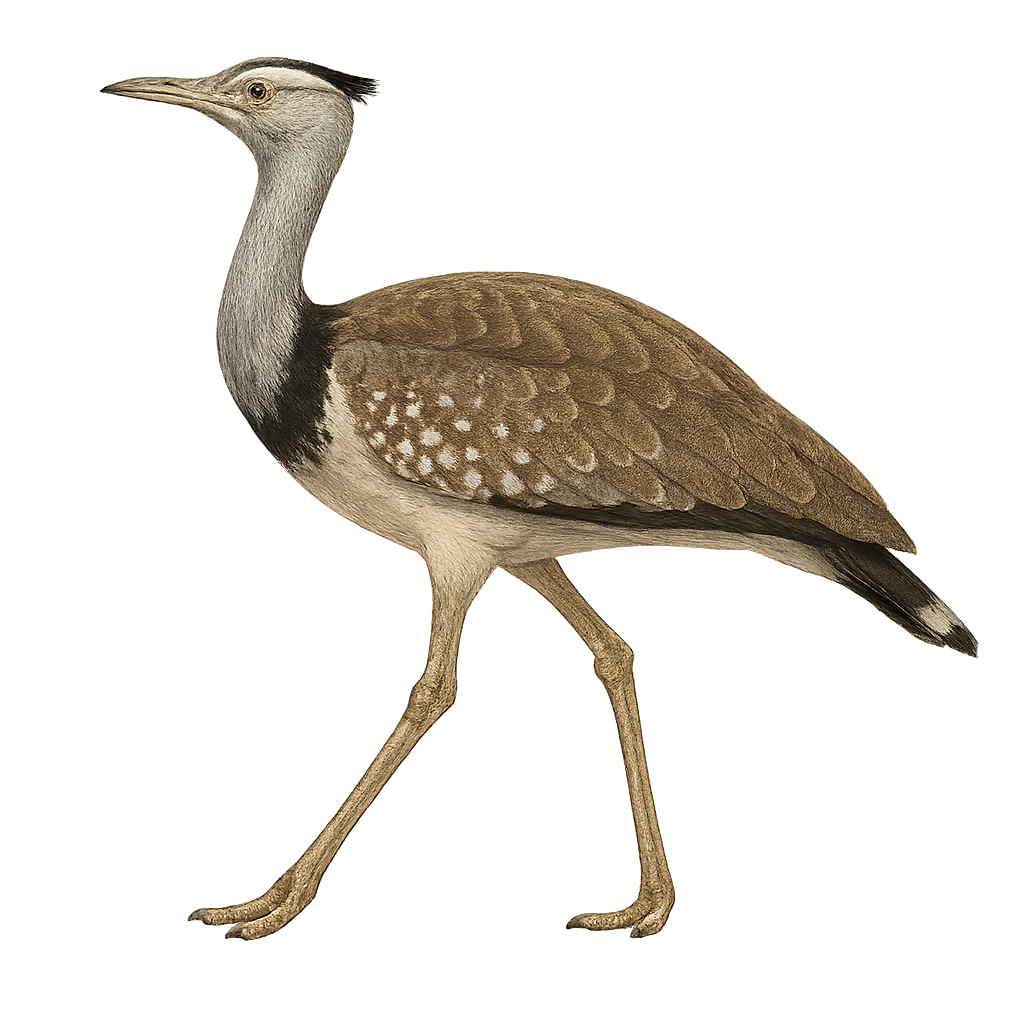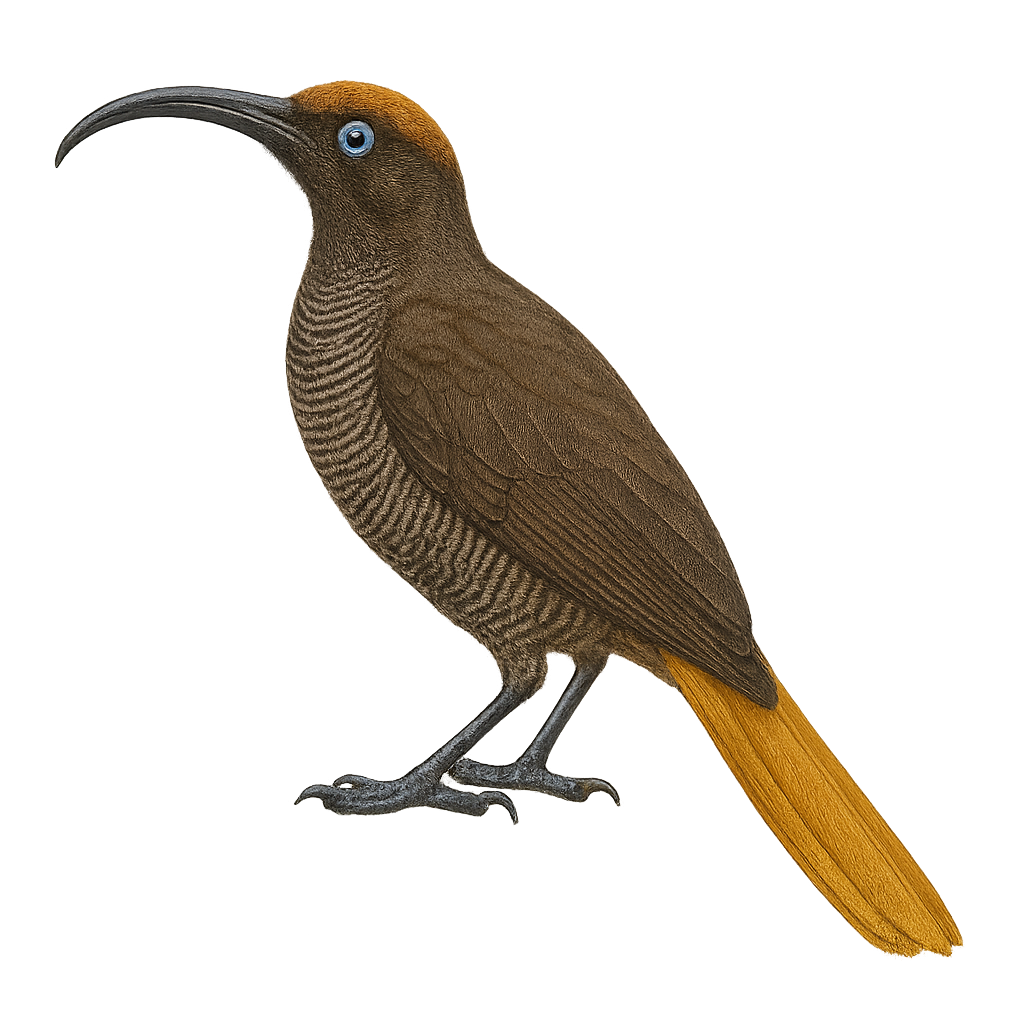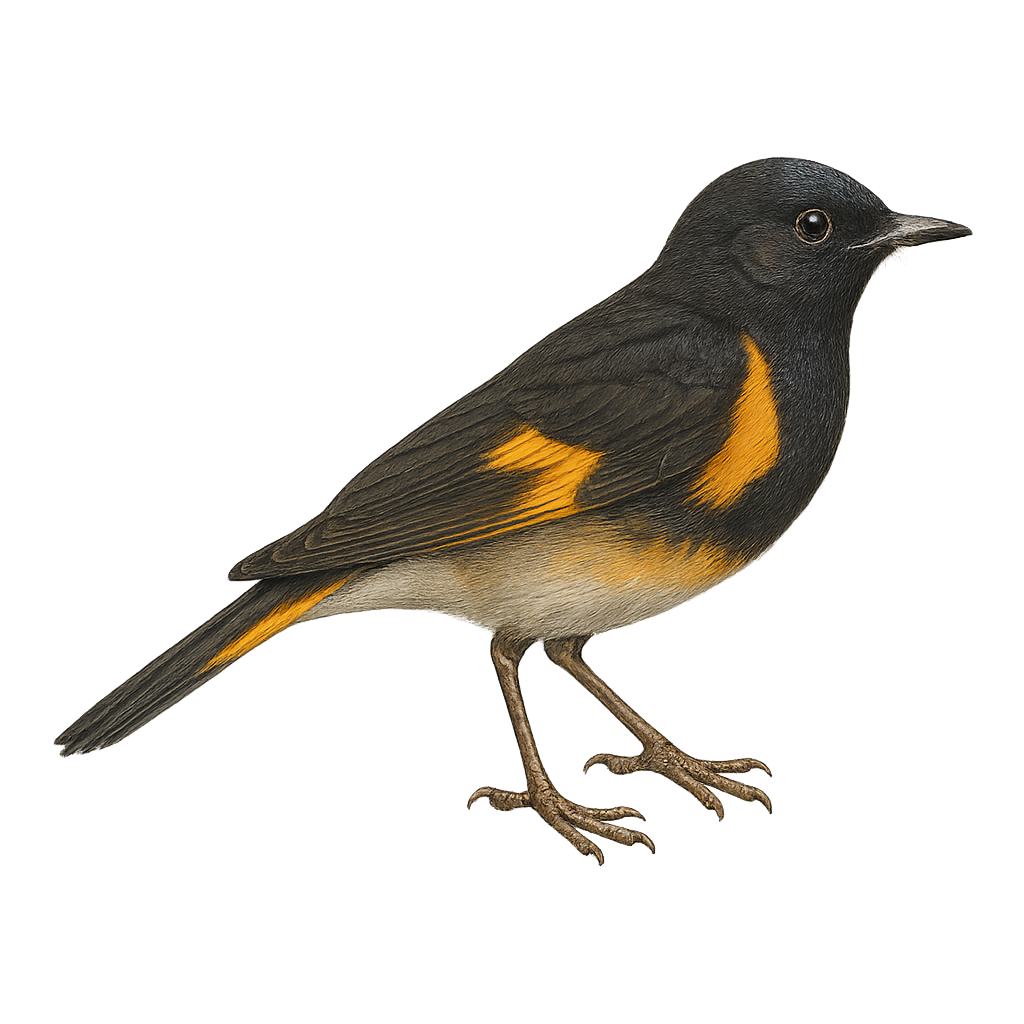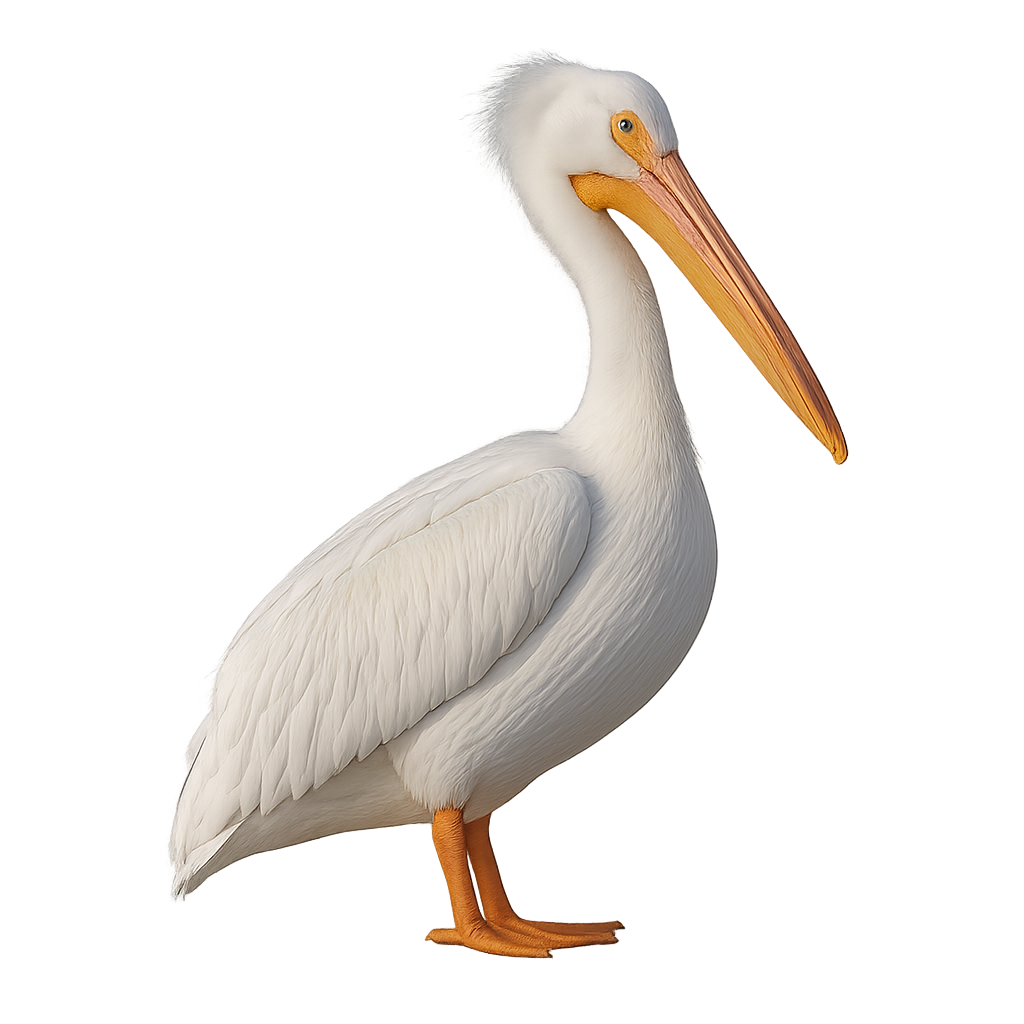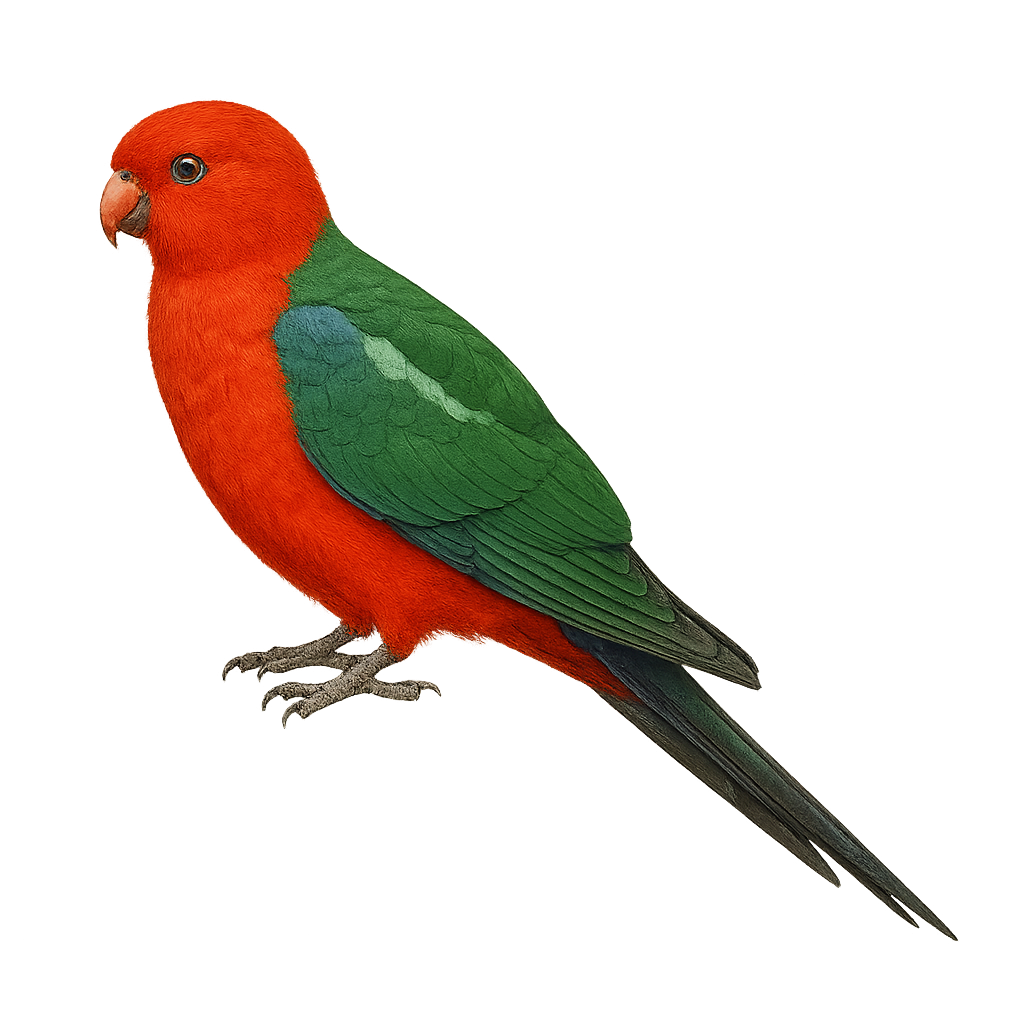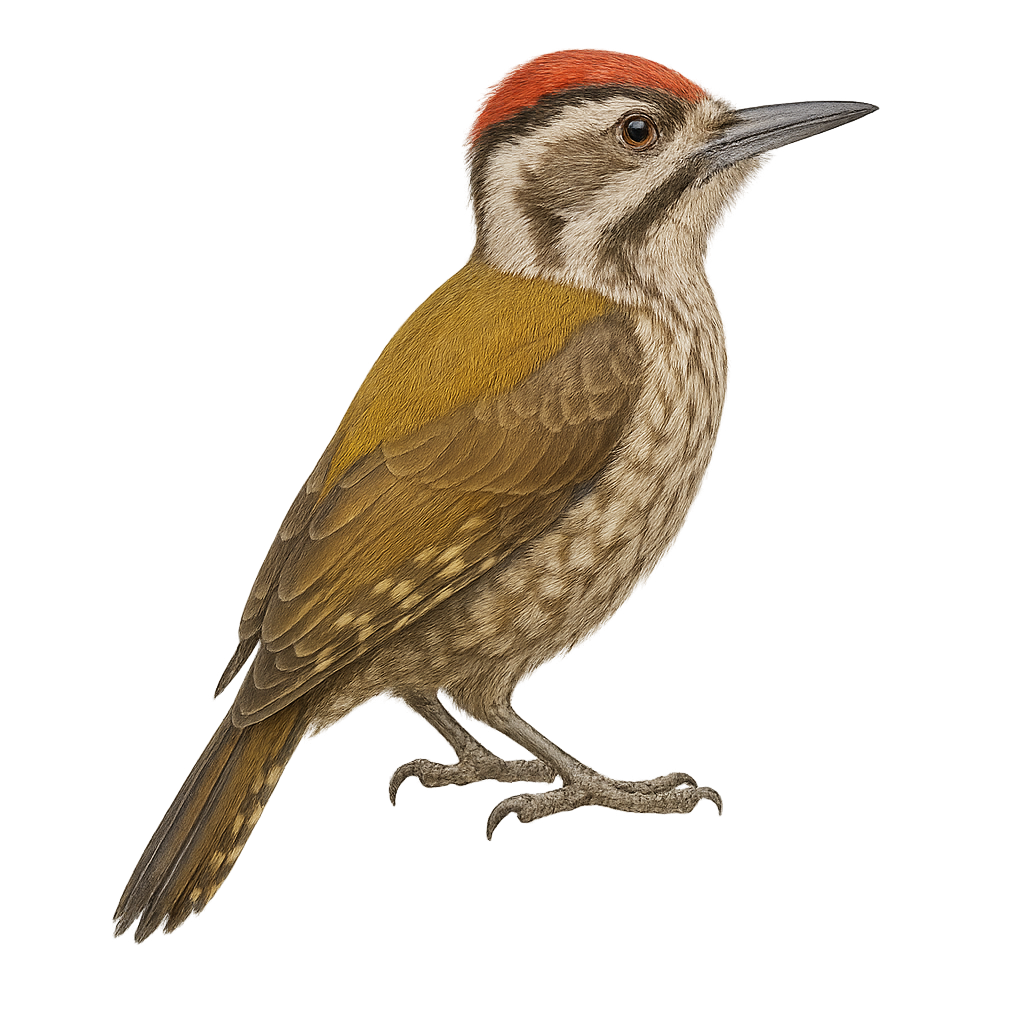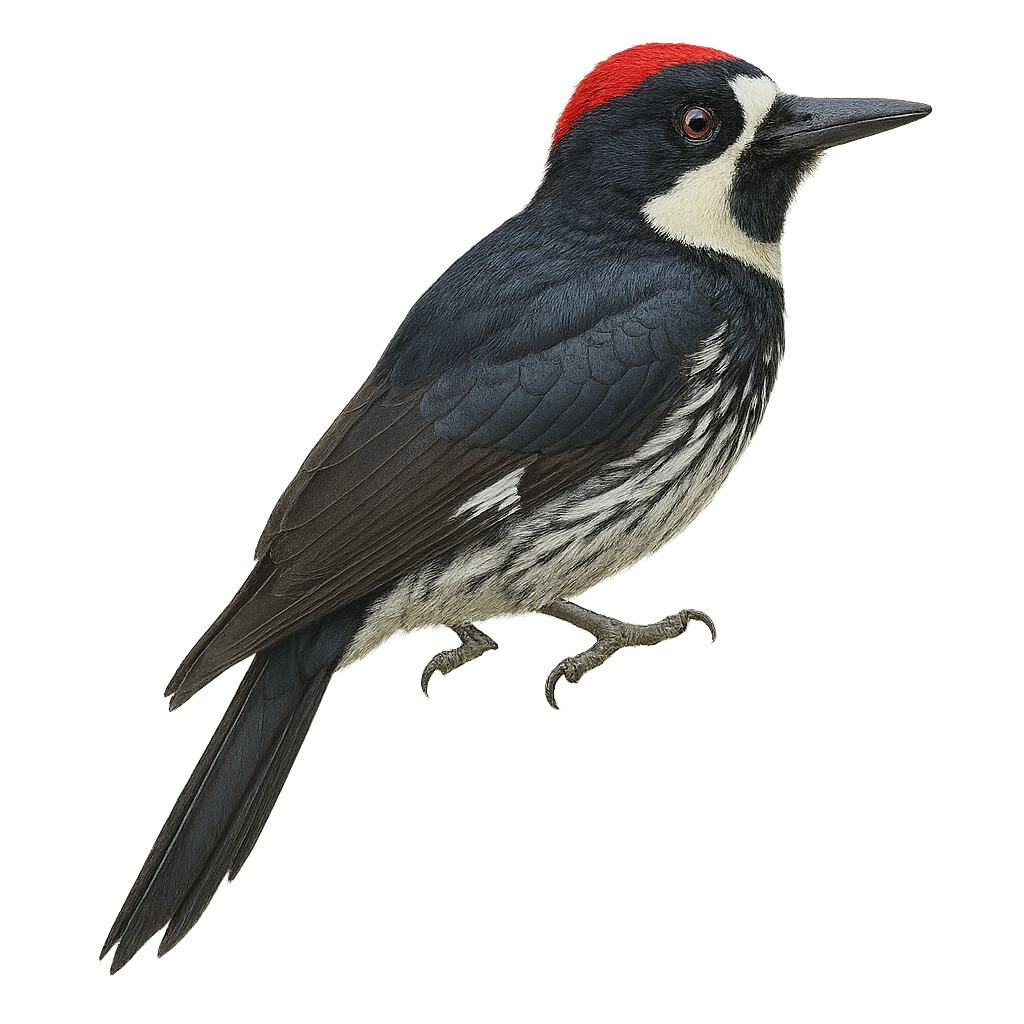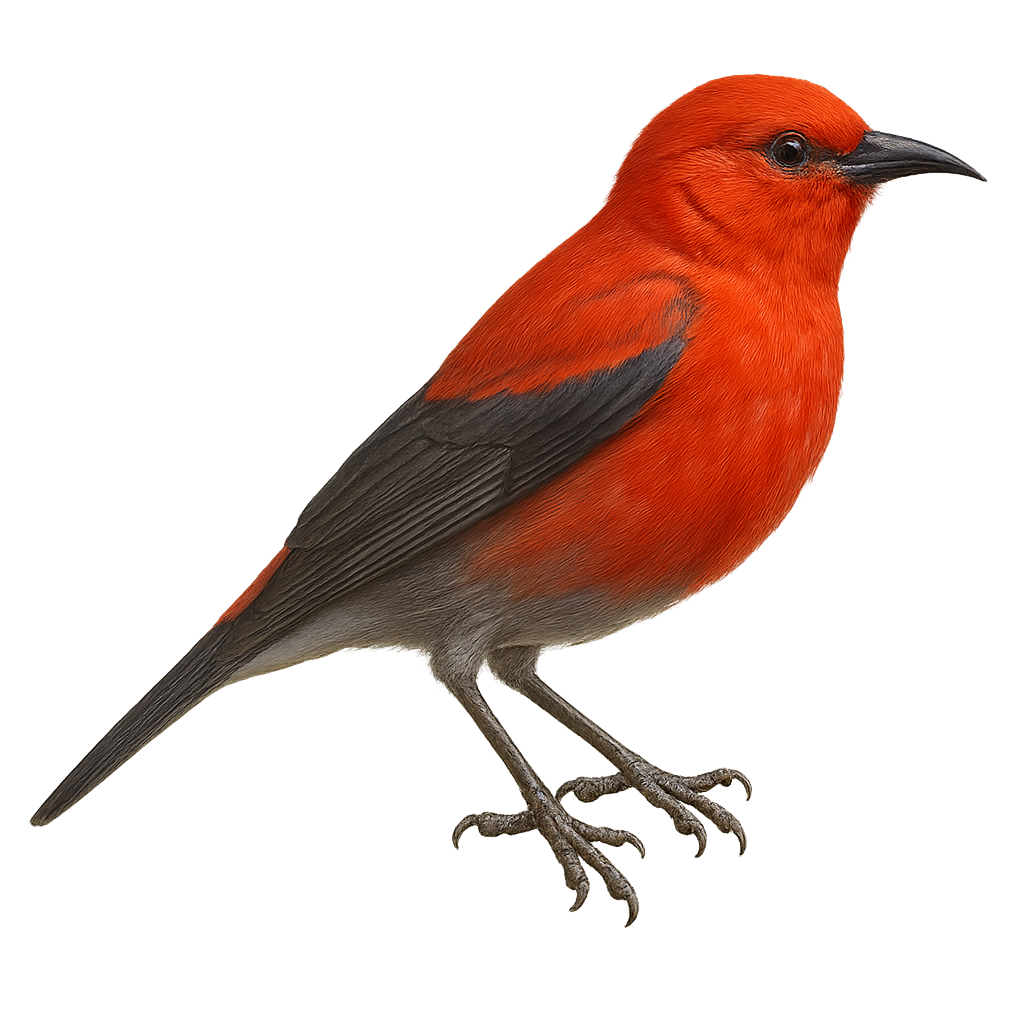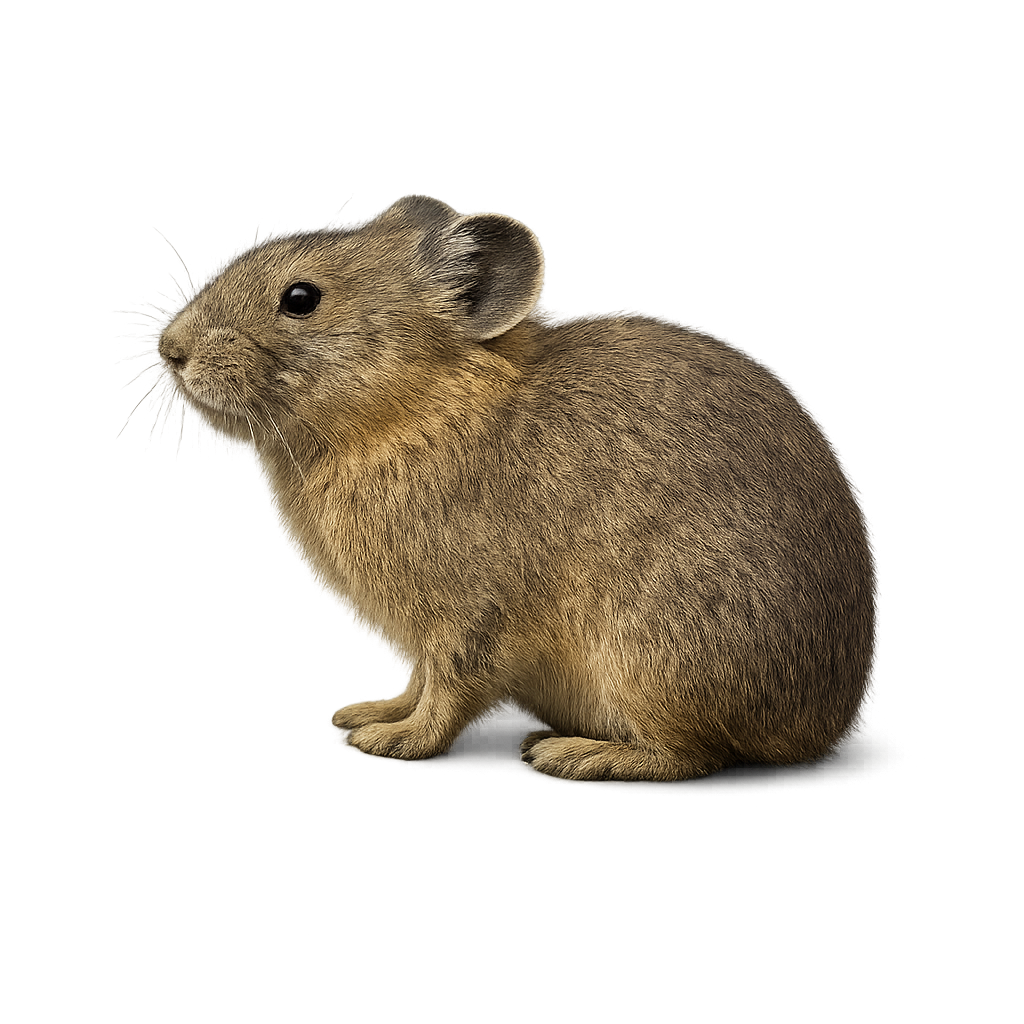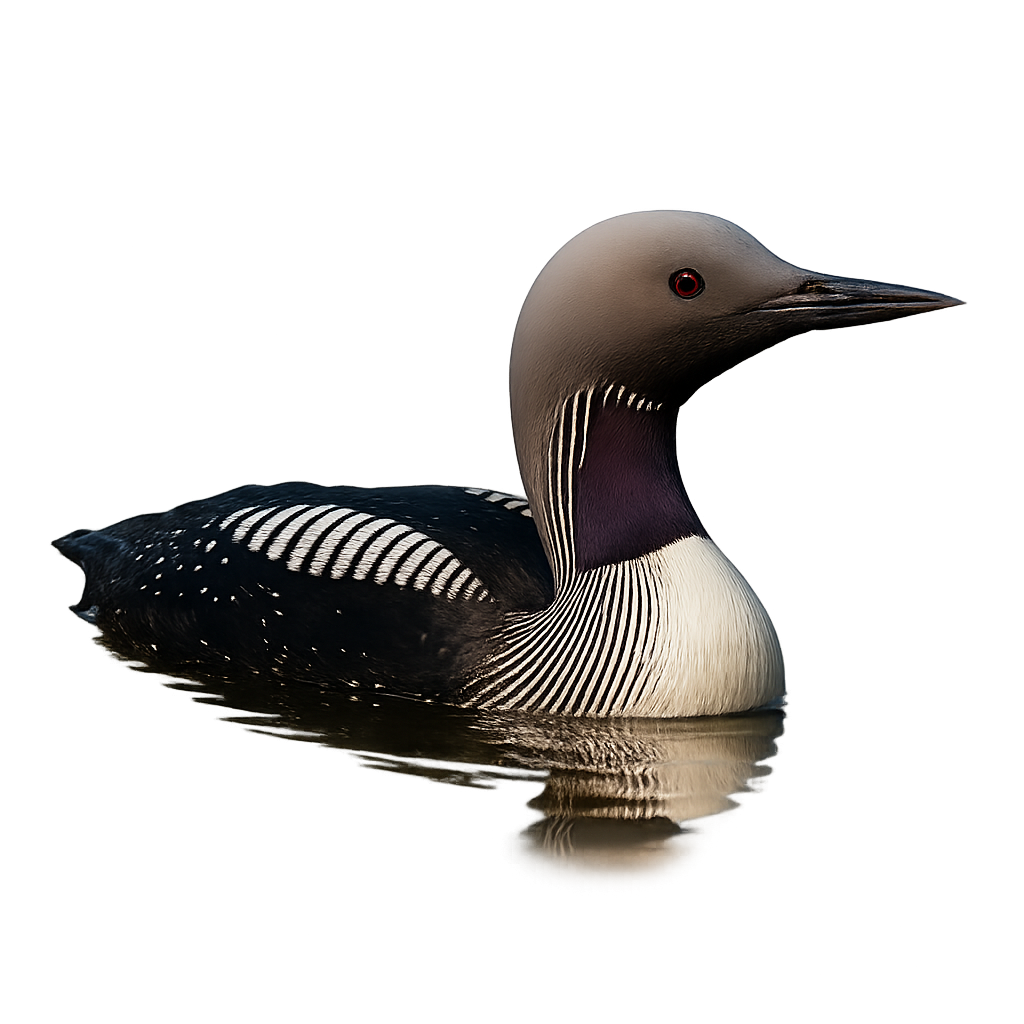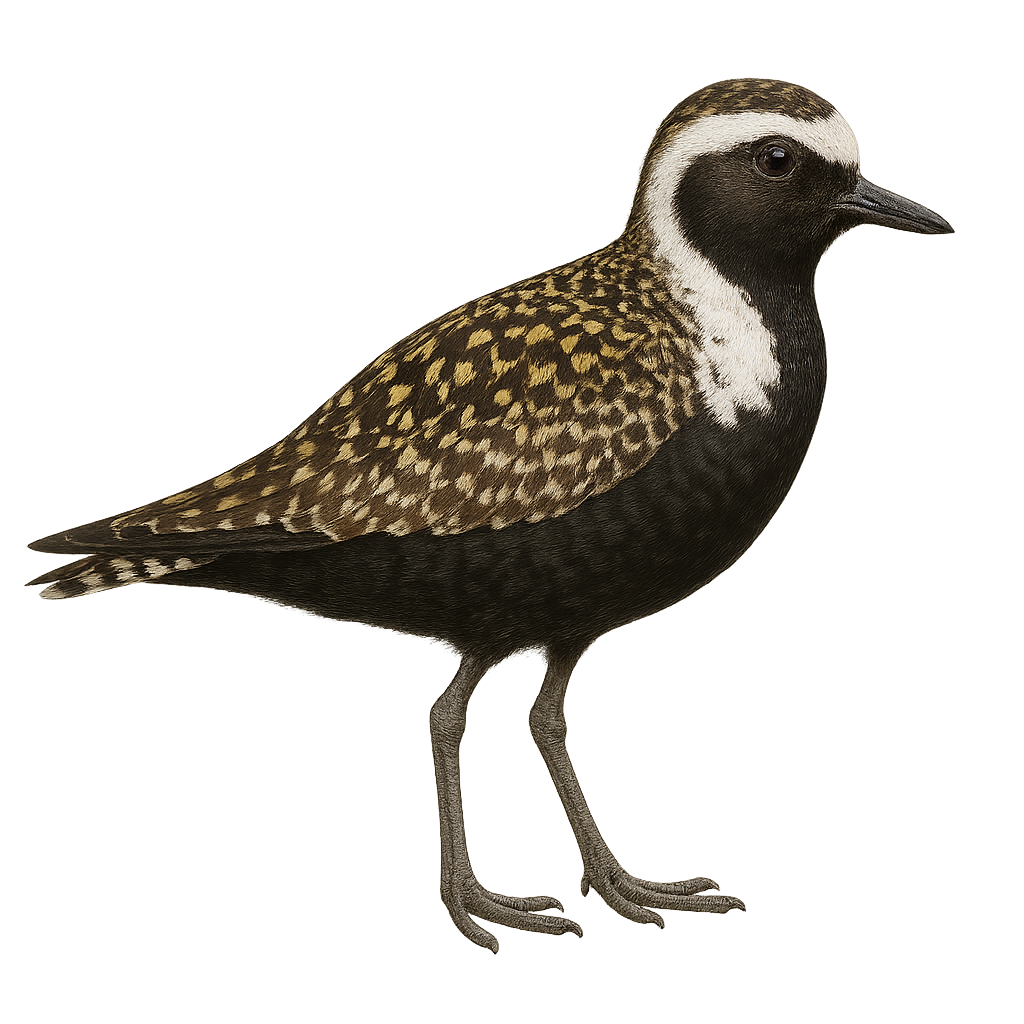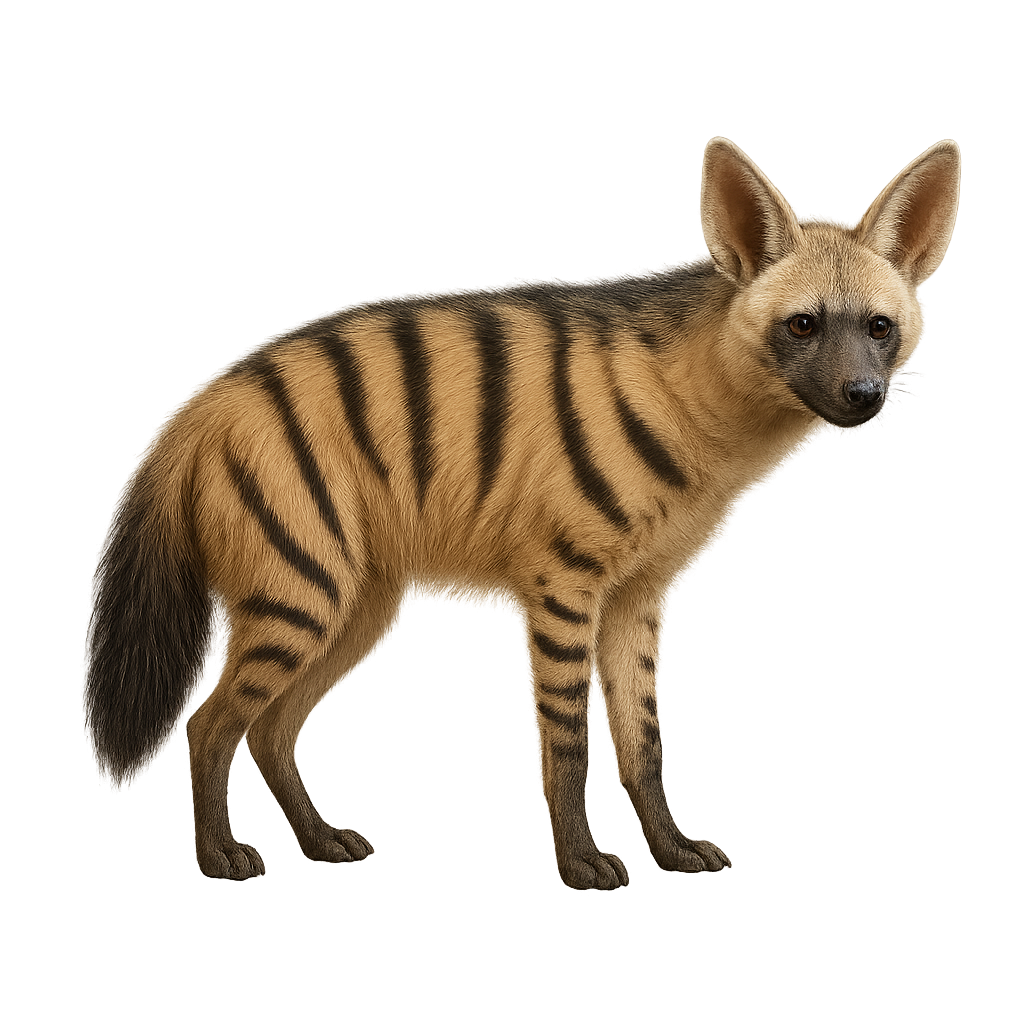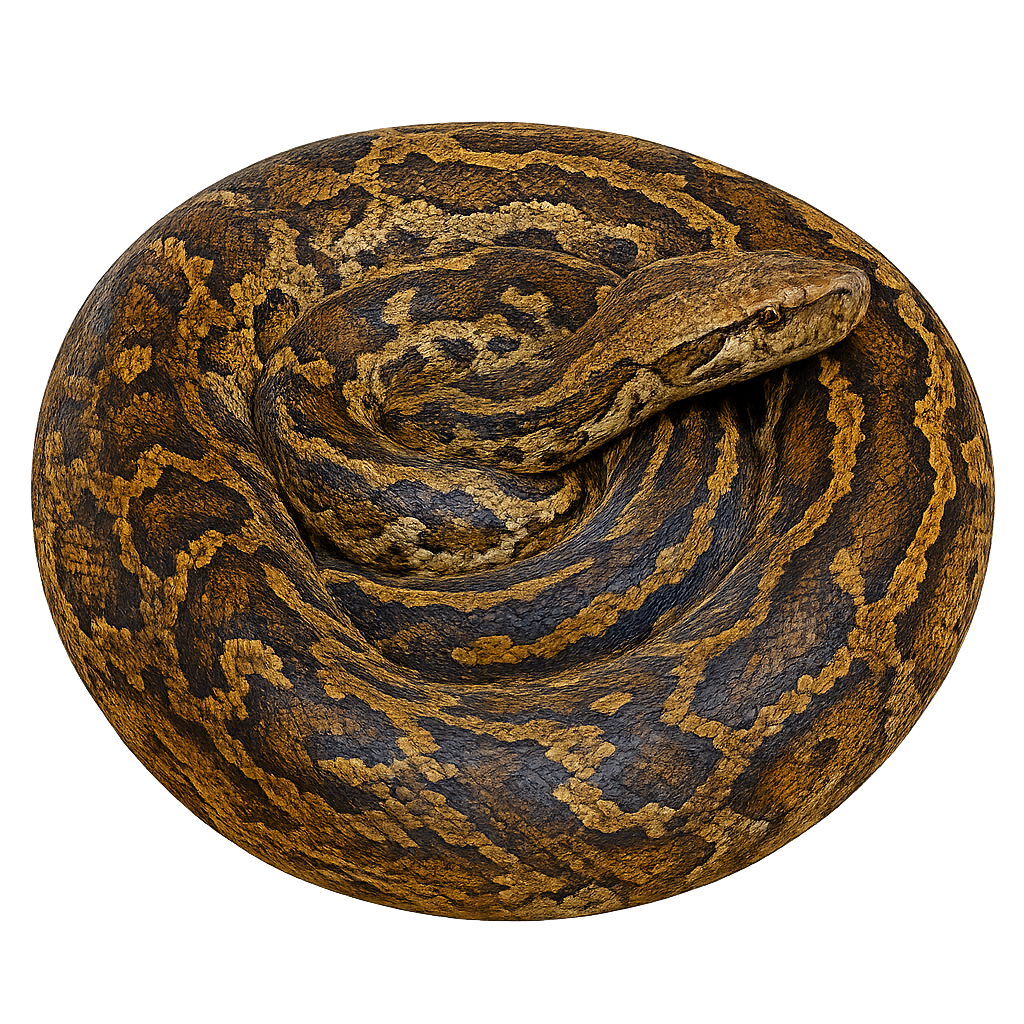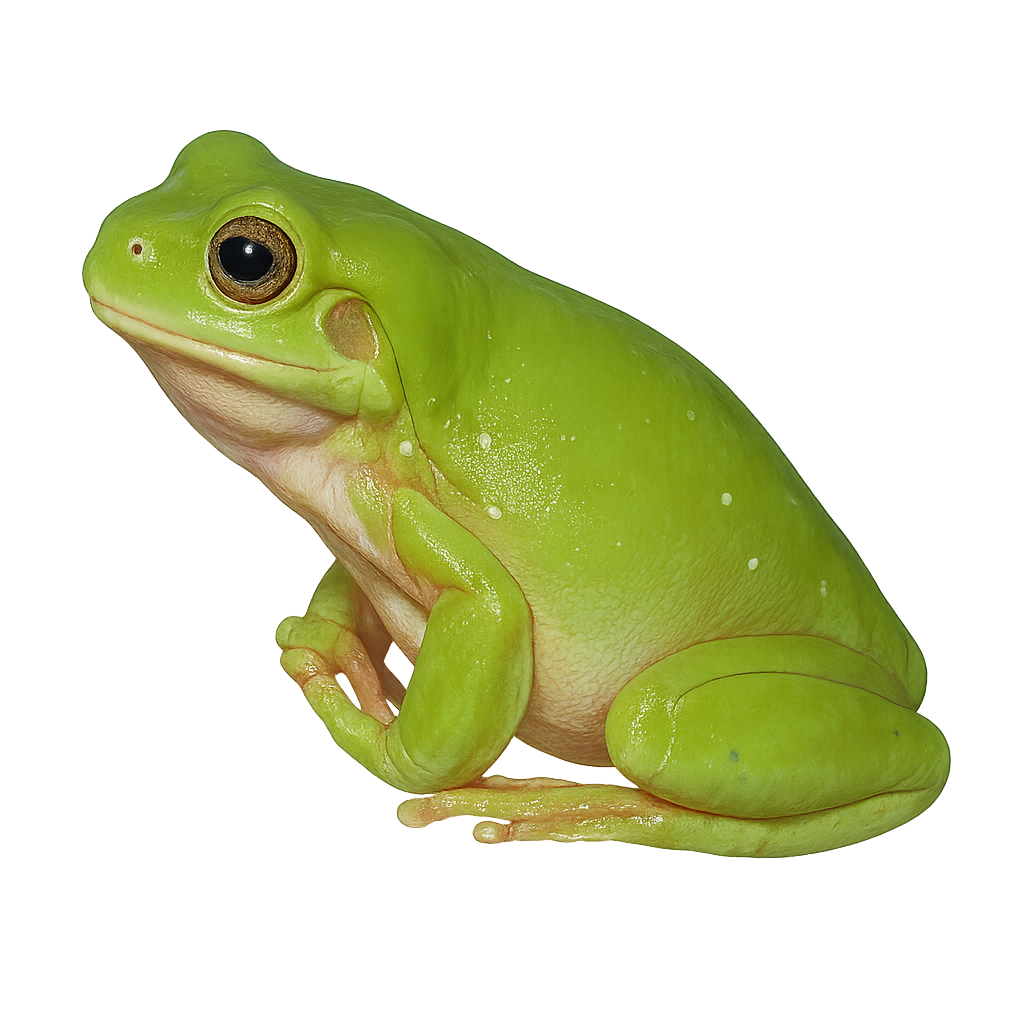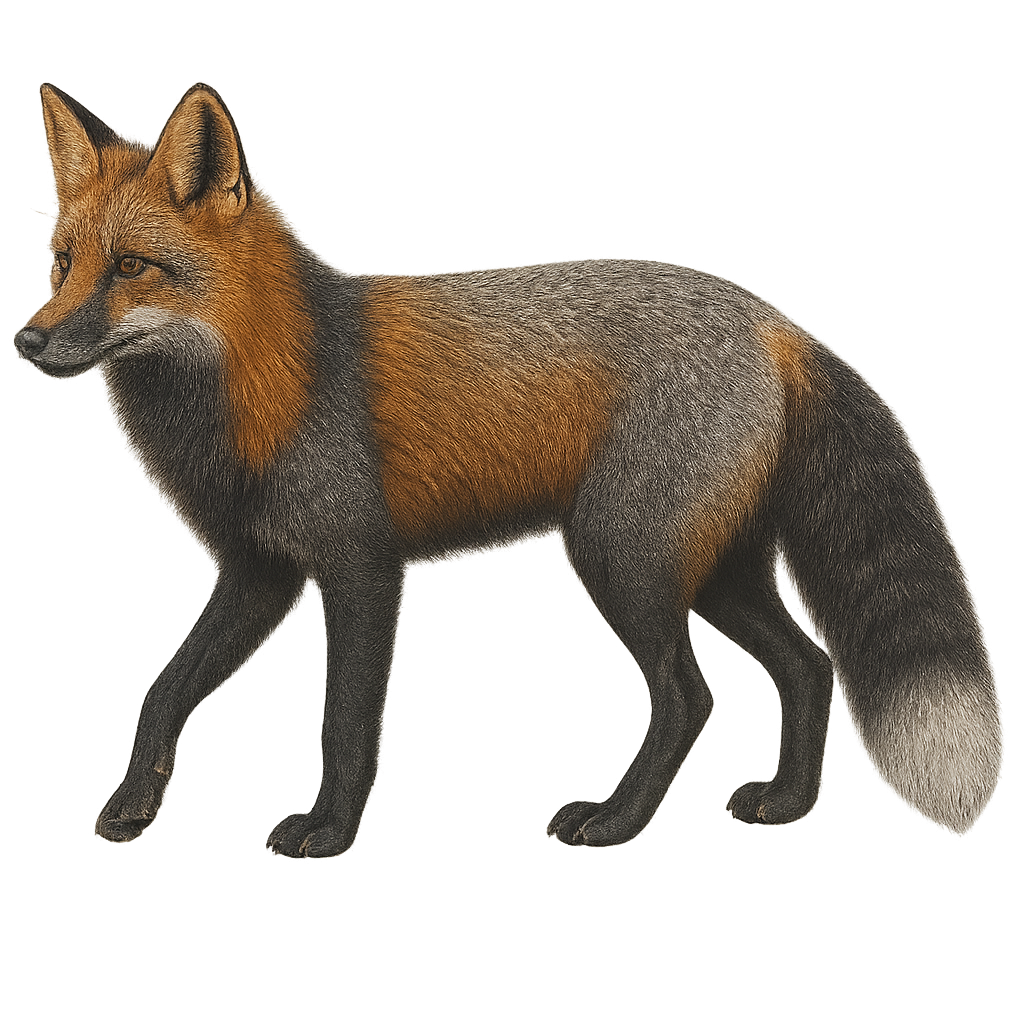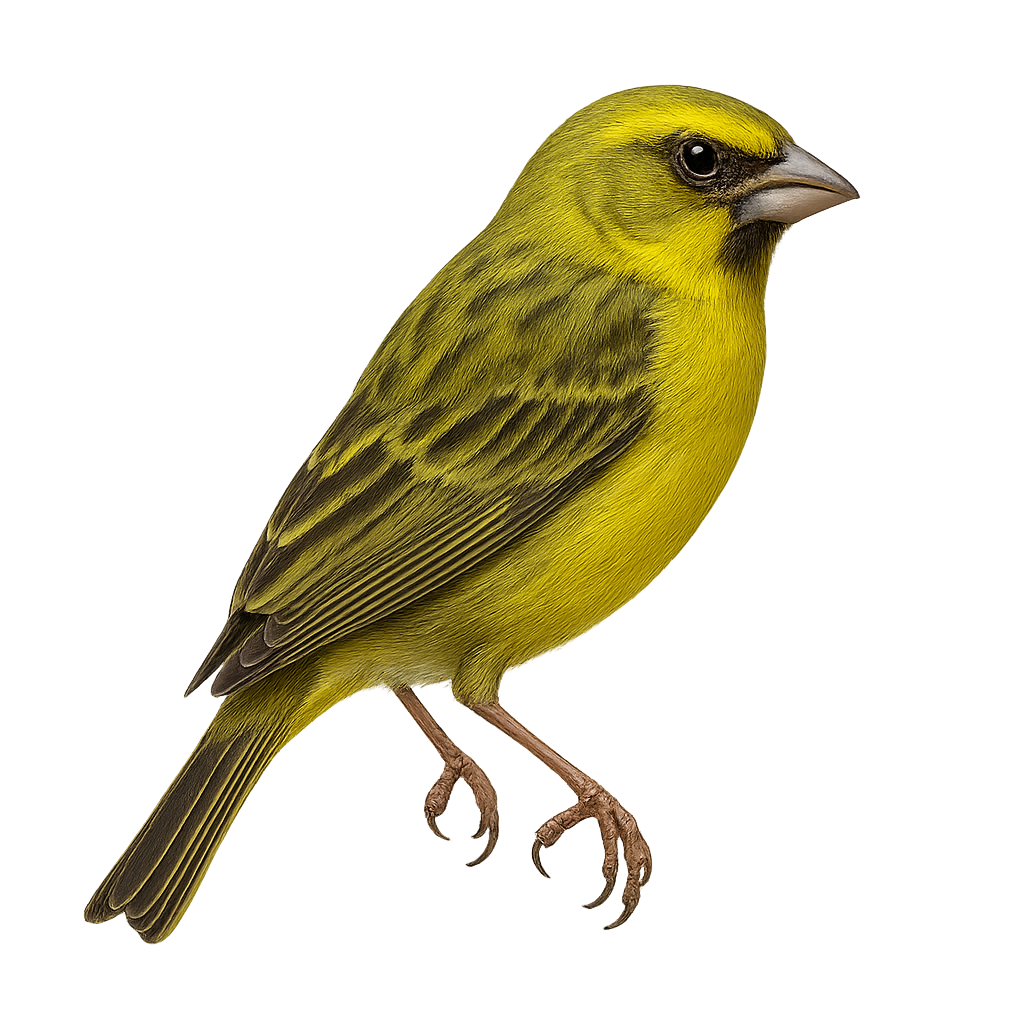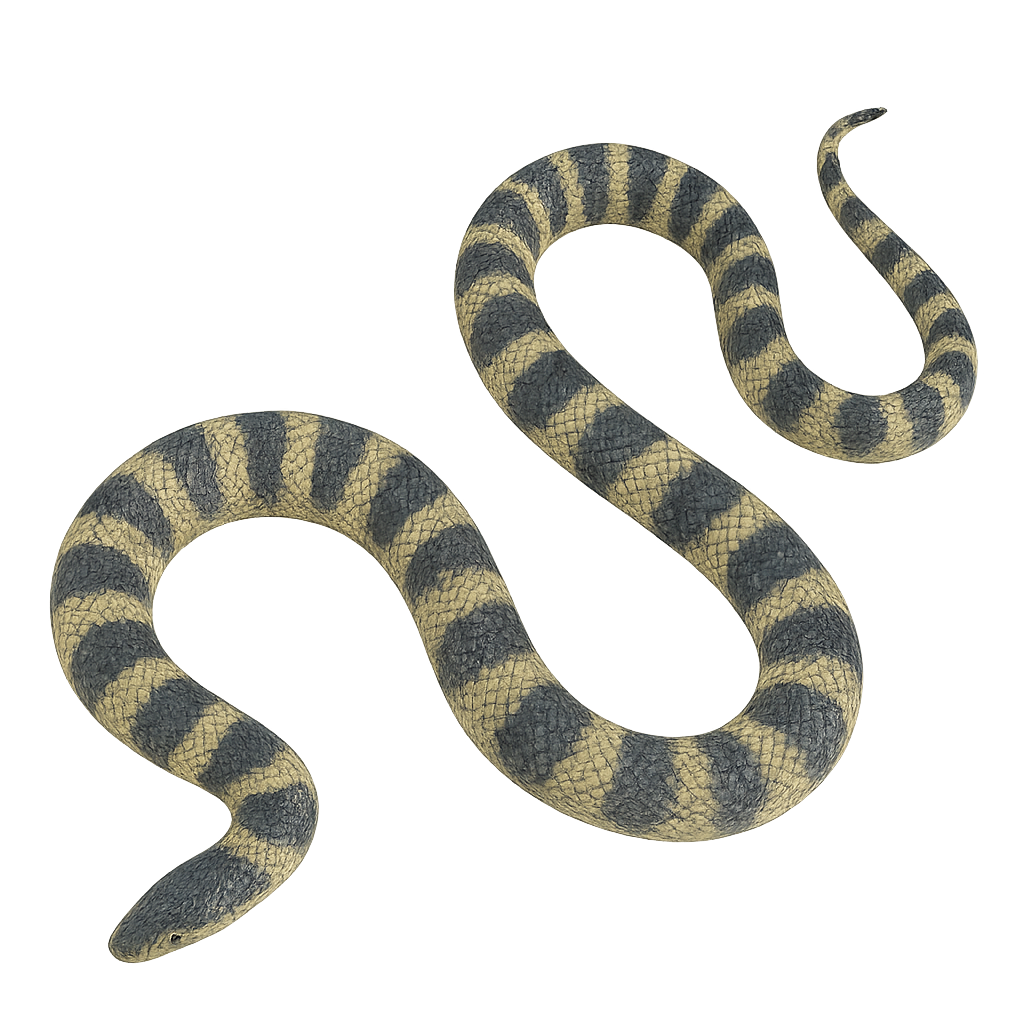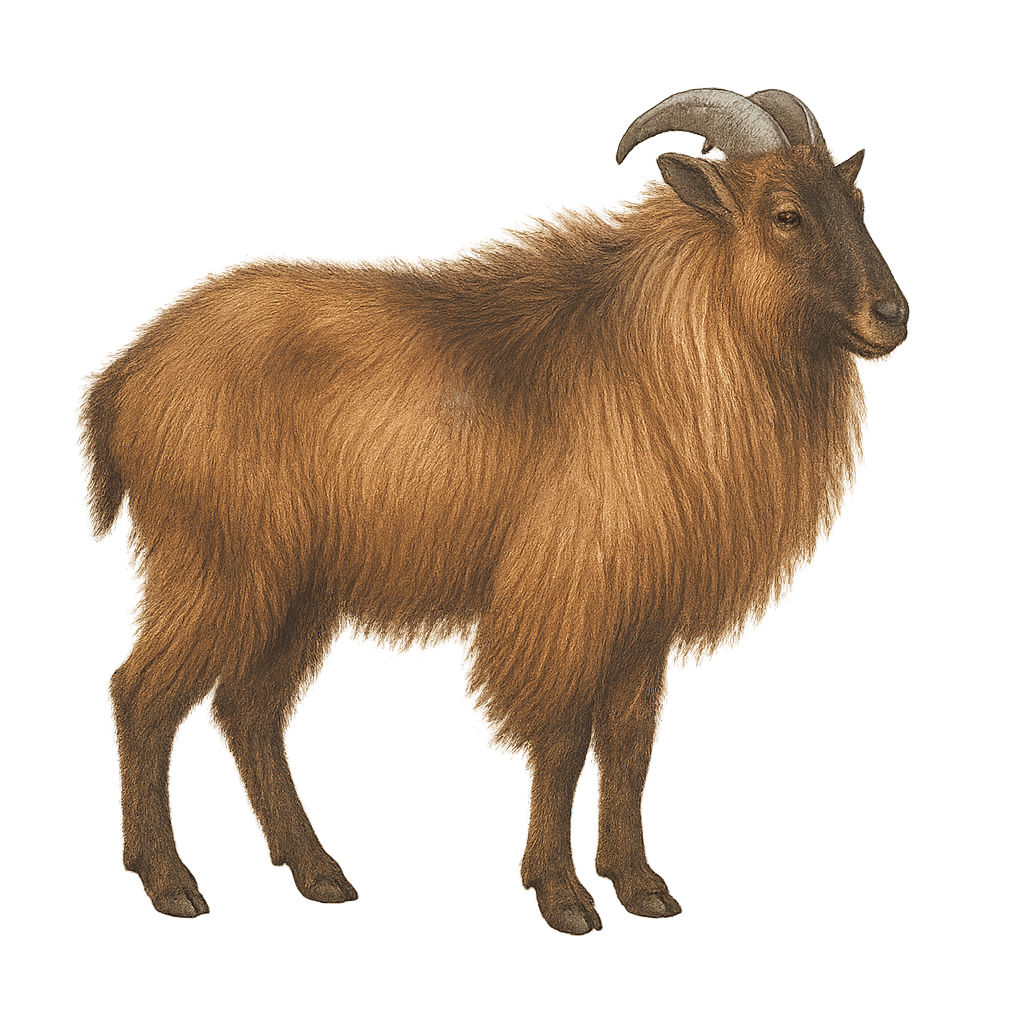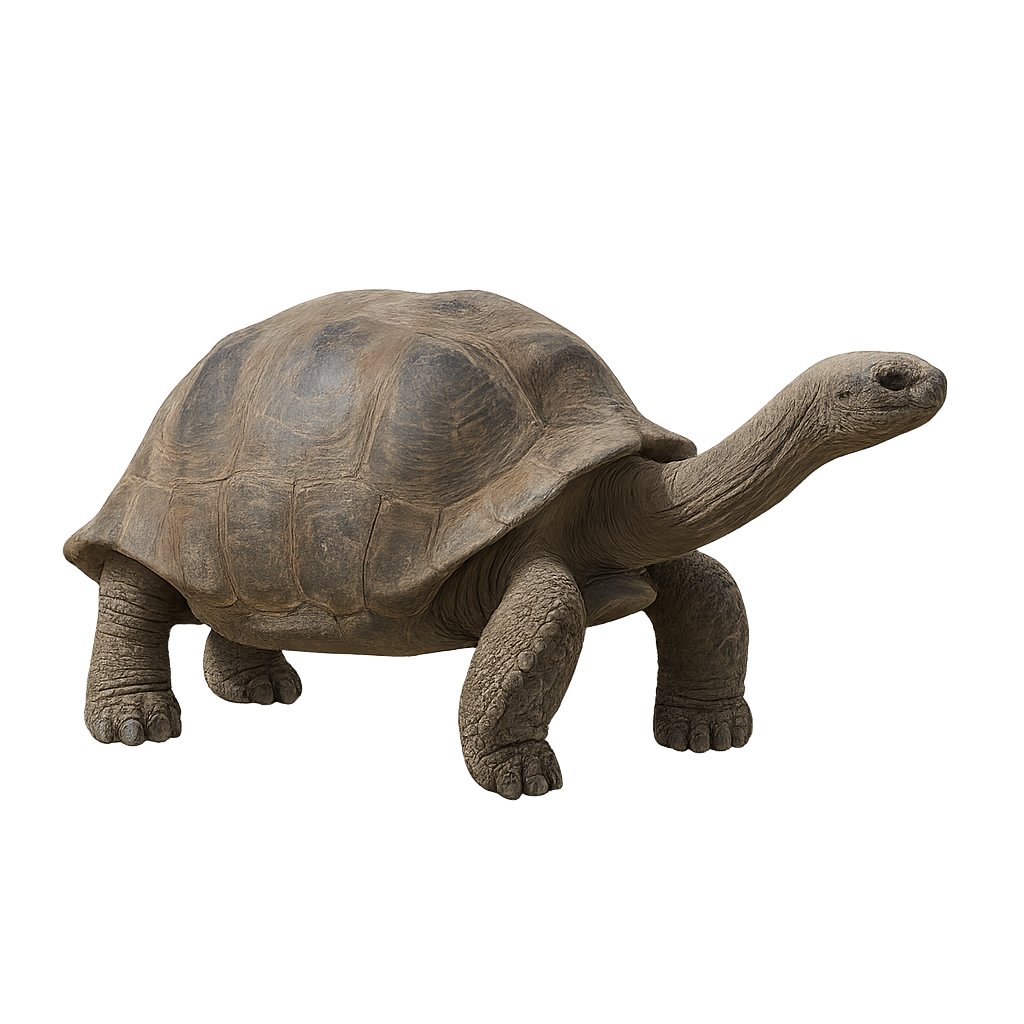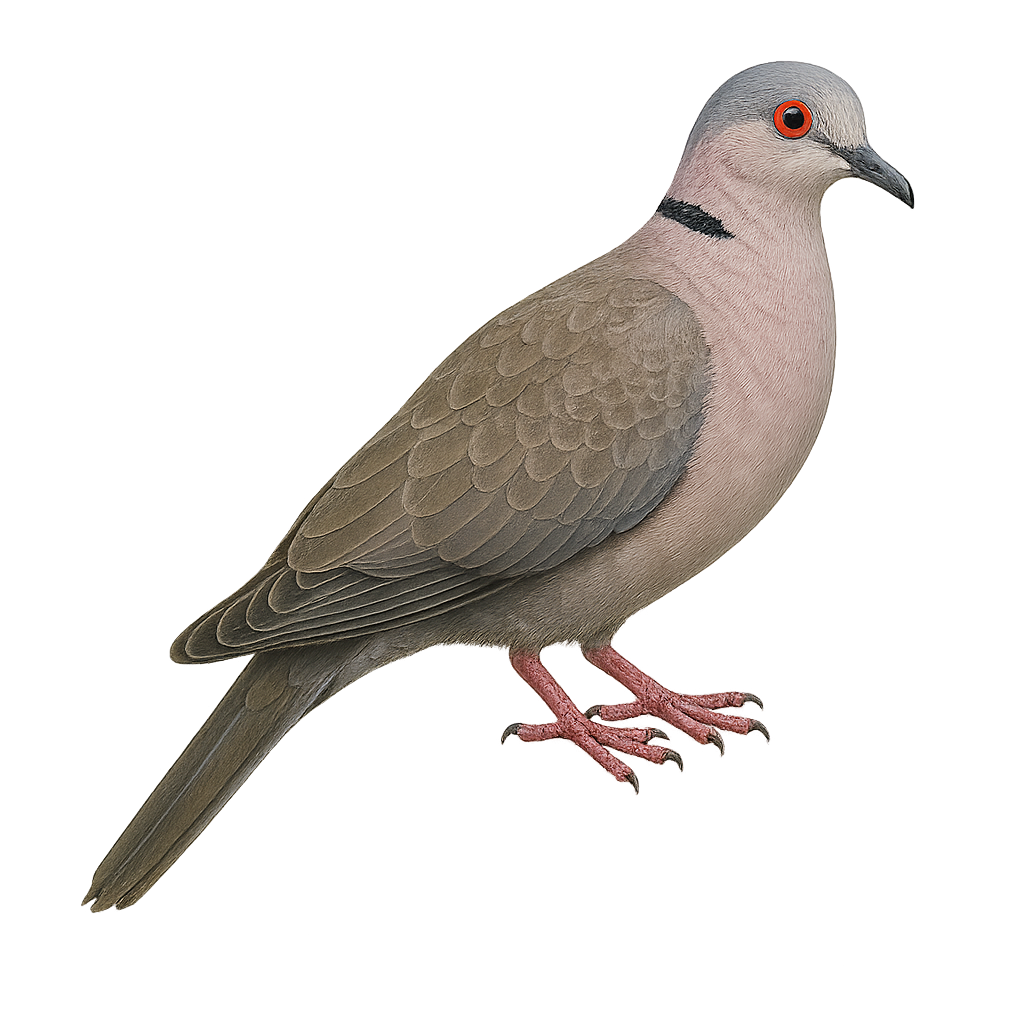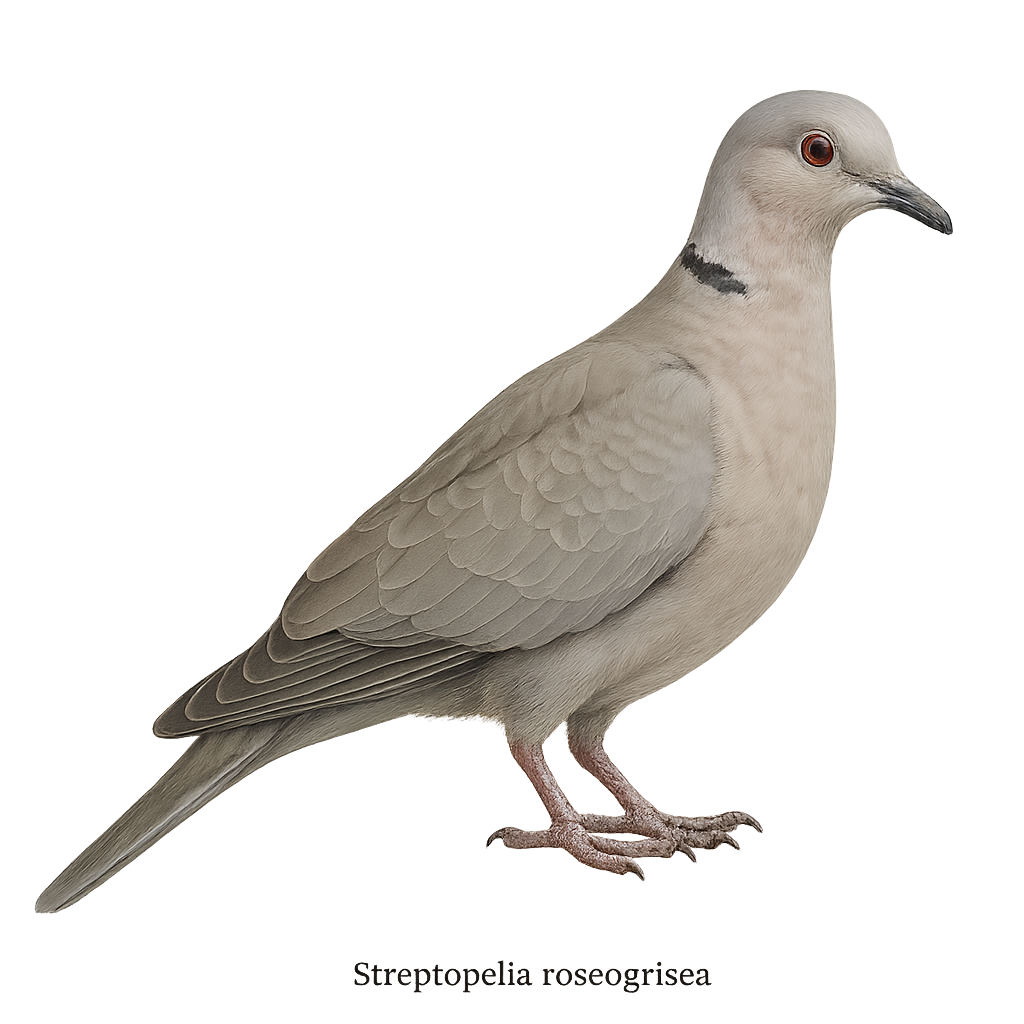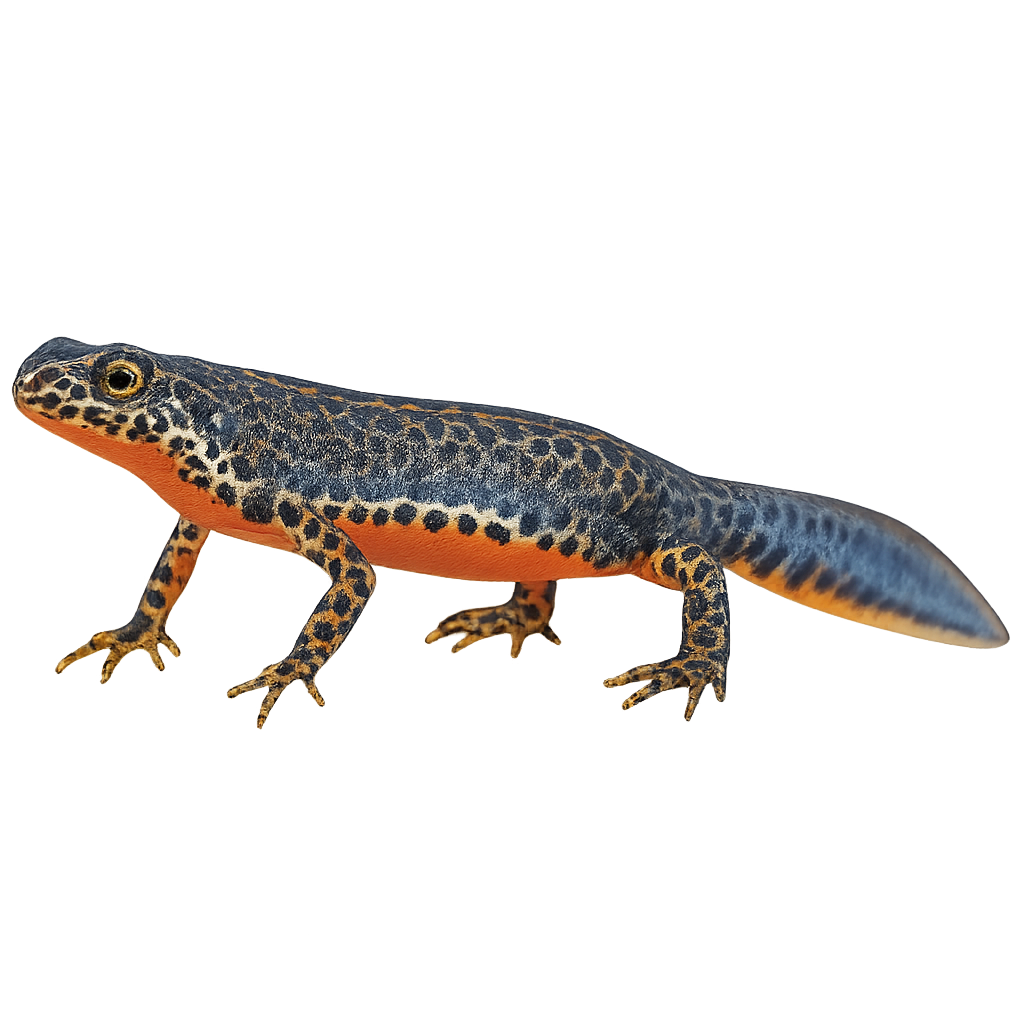The Arabian Bustard, Ardeotis arabs, is a large terrestrial bird primarily inhabiting the arid and semi-arid regions of North Africa and the Arabian Peninsula. It is recognizable by its brown and white plumage, long neck, and sturdy legs. Males are generally larger than females and can reach an impressive wingspan. This bird prefers open plains and savannas where it feeds mainly on seeds, insects, and small vertebrates. Although capable of flight, the Arabian Bustard spends most of its time on the ground. It is known for its spectacular courtship displays where the male puffs up its feathers to attract the attention of females.
The Albertis's Bird-of-paradise, Drepanornis albertisi, is a captivating bird from the Paradisaeidae family, endemic to New Guinea. This medium-sized bird is recognizable by its striking plumage and long ornamental tail. Males display vibrant colors, with shades of green, blue, and yellow, while females have more subdued plumage. The Albertis's Bird-of-paradise primarily inhabits tropical rainforests and mountainous areas, feeding on fruits, insects, and small animals. Its courtship behavior is particularly spectacular, featuring complex dances and melodious vocalizations to attract females. Although its habitat is threatened by deforestation, the species is currently classified as of least concern by the IUCN.
The American Redstart, Setophaga ruticilla, is a small songbird belonging to the Parulidae family. It is easily identifiable by its striking black and orange plumage in males, while females display more subdued shades of gray and yellow. This migratory bird breeds in North America and migrates to Central and South America for the winter. The American Redstart primarily inhabits open forests, groves, and moist wooded areas. It feeds mainly on insects, which it catches in flight with its agile and rapid movements. Its melodious and varied song is often heard in spring and summer, marking its territory and attracting mates.
The Australian Pelican, or Pelecanus conspicillatus, is a large waterbird known for its striking white plumage, black wings, and enormous bill with an expandable pouch. Native to Australia, it frequents inland and coastal waters, primarily feeding on fish. Its impressive wingspan and majestic flight make it a fascinating sight. Although often seen in groups, it can also be solitary. Its ability to glide over long distances is remarkable, using warm air currents to conserve energy. The Australian Pelican is a symbol of Australian wildlife, admired for its beauty and natural elegance.
The American White Pelican, or Pelecanus erythrorhynchos, is a large aquatic bird known for its striking white plumage and bright orange bill. It is primarily found in North America, frequenting lakes, rivers, and wetlands. In flight, its black wings contrast with its white body, creating a majestic silhouette. This gregarious bird feeds mainly on fish, which it captures using its bill's expandable pouch. During the breeding season, it forms colonies on isolated islands. Although its conservation status is currently "least concern," it is sensitive to human disturbances and water pollution.
The Australian King Parrot, scientifically known as Alisterus scapularis, is a vibrant and captivating bird native to eastern Australia. Males are distinguished by their bright red heads, green backs, and wings adorned with red patches, while females have more subdued colors with green heads. These parrots measure about 42 cm in length and are often seen in pairs or small groups. They inhabit rainforests, woodlands, and urban gardens, feeding primarily on seeds, fruits, and flowers. Their song is melodious yet subtle, and they are known for their curious and sociable behavior towards humans.
The Abyssinian Woodpecker, or Dendropicos abyssinicus, is a fascinating bird primarily found in the mountainous forests of East Africa. This medium-sized woodpecker features distinctive plumage with olive-green hues and red markings on the head, more pronounced in males. It is often seen drumming on tree trunks in search of insects, its main food source. Although relatively discreet, its drumming resonates through the forests, signaling its presence. The Abyssinian Woodpecker plays a crucial role in the ecosystem by controlling harmful insect populations. Its ability to adapt to different forest types makes it a resilient bird, although deforestation may threaten its natural habitats.
The Acorn Woodpecker, Melanerpes formicivorus, is a fascinating bird from the Picidae family, easily recognizable by its distinctive black and white plumage and bright red cap. It is primarily found in oak forests of North and Central America, where it plays a crucial role in the ecosystem by dispersing oak seeds. This woodpecker is famous for its unique behavior of storing acorns, which it inserts into holes drilled in tree trunks, forming collective "granaries." Sociable, it often lives in family groups and communicates through a variety of calls. Although primarily insectivorous, it also feeds on fruits and nuts.
The Apapane, or Himatione sanguinea, is an endemic bird of Hawaii, belonging to the Fringillidae family. This medium-sized bird is recognizable by its bright red plumage, contrasting with its black wings and tail. Its curved beak is adapted for nectar consumption, its primary food source, although it also feeds on insects. The Apapane plays a crucial role in pollinating native flowers. It is often observed in high-altitude rainforests, moving in noisy flocks. Although its population is stable, it is threatened by habitat loss and avian diseases. The Apapane is a symbol of the unique biodiversity of the Hawaiian Islands.
The American pika is a small lagomorph mammal, 15–23 cm in length, with a stocky body, short limbs, and small rounded ears, covered in brownish-gray fur. It inhabits alpine rocky slopes and talus fields of North America, from British Columbia to New Mexico, at elevations of 1400–3800 m, feeding on mosses, grasses, and leaves.
The American Golden Plover, Pluvialis dominica, is a medium-sized migratory bird belonging to the Charadriidae family. It is characterized by its golden, speckled plumage, which provides excellent camouflage in its natural habitat. During the breeding season, the male displays a striking black breast contrasting with its golden back. This bird is renowned for its long migrations, traveling thousands of kilometers between its breeding grounds in North America and its wintering areas in South America. It primarily inhabits open grasslands, fields, and muddy shores. Its diet mainly consists of insects, worms, and small crustaceans.
The aardwolf, or Proteles cristata, is an insectivorous mammal belonging to the Hyaenidae family, although it differs from hyenas by its diet, which mainly consists of termites. It is recognizable by its striped coat, erect mane, and slender build. Aardwolves are primarily nocturnal, allowing them to avoid the daytime heat in the arid and semi-arid regions of East and Southern Africa where they reside. They dig burrows to rest and protect themselves from predators. Although solitary, they can be observed in small family groups. Their ability to digest termites is aided by a long, sticky tongue.
The African rock python is one of the largest snakes in Africa, reaching lengths of up to 7 meters. It has a robust body covered in intricate patterns of brown, yellow, and black scales, providing excellent camouflage in its natural habitat. This primarily nocturnal snake preys on a variety of animals, from rodents to antelopes. Although non-venomous, it kills its prey through constriction. Often found near water, it is an adept swimmer. Its presence is crucial for ecological balance, yet it faces threats from hunting and habitat loss.
Litoria dayi, commonly known as the Australian Lace-lid, is a tree frog species endemic to Australia. It is characterized by its smooth skin and bright green coloration, often with brown spots. This frog is primarily nocturnal and prefers humid tropical rainforests, where it hides among leaves and branches. Known for its distinctive call, it uses this to attract mates during the breeding season. Although generally discreet, it can be observed near water bodies where it breeds. Unfortunately, Litoria dayi is threatened by habitat loss and diseases, leading to a decline in its population.
The Litoria caerulea, commonly known as the Australian Green Tree Frog, is a species of arboreal frog native to Australia and New Guinea. It is easily recognizable by its smooth, shiny skin, which is typically emerald green, although some may exhibit bluish hues. This frog is known for its longevity, living up to 16 years in captivity. It has adhesive discs on its fingers, allowing it to climb vertical surfaces with ease. The Australian Green Tree Frog is often found in humid areas, rainforests, and urban gardens. Its docile nature makes it a popular pet.
The Arctic Fox is a small carnivore found in the Arctic regions, primarily in Alaska, Canada, Scandinavia, and Russia. It measures about 45 to 50 cm in length, with a tail of 30 to 35 cm, and weighs between 3 and 9 kg, depending on the seasons. Its fur is typically white in winter, allowing it to camouflage in the snow, while it takes on a more brown or grayish hue in summer to blend in with the rocky and grassy landscapes. The Arctic Fox is an opportunistic omnivore, feeding on small mammals, birds, eggs, fruits, and berries. Although well adapted to the extreme living conditions of the Arctic, it is threatened by climate change, which is altering its natural habitat and the availability of its prey.
The Vulpes vulpes alascensis, or Alaskan Red Fox, is a subspecies of the red fox found primarily in coastal and interior regions of Alaska. This fox is well adapted to cold climates, with a dense and thick coat that protects it from extreme temperatures. Its fur ranges from bright red to dark brown, with a characteristic bushy tail. An opportunistic feeder, it preys on small mammals, birds, insects, and occasionally fruits. Although primarily nocturnal, it can be seen at dawn and dusk. The Alaskan Red Fox is a solitary animal, except during the breeding season. It is known for its intelligence and ability to adapt to various environments, allowing it to survive in harsh conditions.
The African straw-coloured fruit bat is a fruit-eating bat species native to sub-Saharan Africa. This bat is easily recognizable by its golden or straw-colored fur, which helps it blend into the foliage during the day. The African straw-coloured fruit bats primarily feed on fruits, nectar, and pollen, playing a crucial role in pollinating plants. They form large colonies and are often seen in flight at dusk as they head out to search for food. These bats can also travel long distances, making them adaptable to a wide range of habitats.
The Alpine salamander is a terrestrial amphibian of the Alpine arc, with a shiny black body and short limbs. It inhabits humid montane forests and alpine meadows above 700 m, feeding on insects and small invertebrates. During the breeding season, males and females meet on damp ground to mate, without returning to water.
The African Citril, or Crithagra citrinelloides, is a small songbird belonging to the Fringillidae family. It is characterized by its bright yellow plumage, especially vivid on the forehead and chest, contrasting with darker wings and tail. This passerine is mainly found in East Africa, where it inhabits woodlands, savannas, and gardens. Its melodious song is often heard at dawn and dusk. The African Citril is a sociable bird, often seen in small groups. It primarily feeds on seeds but can also consume insects. Its adaptability to various habitats makes it a resilient species, although some populations may be affected by deforestation.
The annulated sea snake is a highly venomous marine elapid, 1–1.5 m long, identifiable by its black and yellow rings covering its slender, elongated body. It inhabits coral reefs, tropical seagrass beds, and shallow lagoons of the Indo-Pacific, feeding on fish and small bony fishes. Solitary and elusive, it employs sinuous undulations and visual cues to hunt.
The African Spoonbill, or Platalea alba, is a striking wading bird known for its spoon-shaped bill, which it uses to sift through water for food. It boasts a bright white plumage that contrasts with its reddish legs and bill. This bird is primarily found in the wetlands of sub-Saharan Africa, frequenting marshes, lakes, and rivers. The African Spoonbill is a gregarious bird, often seen in groups, and feeds mainly on small fish, crustaceans, and aquatic insects. Its breeding season varies by region but is generally tied to the rainy season when food resources are plentiful.
The Arctic Tern is a migratory bird species primarily found in coastal regions of the Arctic during the summer, and in tropical and subtropical areas during the winter. It measures about 35 to 40 cm in length, with a wingspan of 80 to 100 cm, and weighs between 90 and 130 g. Its plumage is mostly white with gray tones on the back and wings, and its head is black with a distinctive black band around the eyes. The Arctic Tern is famous for its impressive migrations, traveling thousands of kilometers between its breeding sites in the Arctic and its wintering grounds in Africa, Southeast Asia, and Australia. It primarily feeds on fish and marine invertebrates, which it catches by diving into the water. While its population remains stable, the Arctic Tern is threatened by habitat loss, human disturbances, and climate change.
The Arabian tahr, Hemitragus jayakari, is a species of wild goat native to the arid mountains of Oman and the United Arab Emirates. This robust mammal is well adapted to rugged, rocky terrains, where it primarily feeds on grasses, leaves, and fruits. Males are distinguished by their thick, curved horns, while females have smaller horns. Its dense, brownish coat allows it to blend into its rocky environment. The Arabian tahr is a gregarious animal, living in small groups, although adult males are often solitary. This species is threatened by habitat loss and hunting, leading to its classification as vulnerable by the IUCN.
The Asian Paradise Flycatcher, or Terpsiphone paradisi, is an elegant and fascinating bird known for its long tail feathers in males. It boasts a striking white plumage with a black head and distinctive crest. Females are more subdued with brownish hues. This bird is primarily insectivorous, feeding on flies, butterflies, and other small insects caught in flight. It is often found in tropical and subtropical forests, as well as gardens and parks. The Asian Paradise Flycatcher is a partial migrant, moving seasonally to find optimal living conditions.
The Aldabra giant tortoise, scientifically known as Aldabrachelys gigantea, is one of the largest land tortoises in the world. Native to the Aldabra Atoll in the Seychelles, it can weigh up to 250 kg and measure over a meter in length. Its domed shell and sturdy legs allow it to move slowly but steadily across its island habitat. As a herbivore, it primarily feeds on grasses, leaves, and fruits. This tortoise is a symbol of longevity, often living over 100 years. Although protected, it remains vulnerable to threats such as habitat loss and climate change.
The African Mourning Dove, scientifically known as Streptopelia decipiens, is an elegant and graceful bird primarily found in sub-Saharan Africa. It is distinguished by its delicate plumage, blending shades of gray, brown, and white, with a characteristic black band on its neck. This bird prefers open habitats such as savannas, agricultural areas, and urban gardens, where it can easily find seeds and small fruits to feed on. The African Mourning Dove is often seen in pairs or small groups, and its soft and melodious call is a familiar sound in its range. Although generally discreet, it can become more visible during the breeding season when it performs aerial courtship displays.
The African Collared Dove, or Streptopelia roseogrisea, is an elegant and graceful bird, often mistaken for the domestic dove. It features delicate plumage, primarily pinkish-grey, with darker shades on the wings and a distinctive black band around the neck. This bird is particularly appreciated for its soft and melodious song. Native to the arid regions of sub-Saharan Africa, it adapts well to semi-arid environments and savannas. It is often seen in pairs or small groups, feeding mainly on seeds and small insects. Although generally discreet, it can be spotted near water sources, especially at sunrise and sunset.
The Alpine newt is a small urodele amphibian, 9–13 cm long, with a bright olive back and orange belly. It inhabits ponds, pools, and wooded wetlands across temperate Europe. During the breeding season, males develop a colored tail crest and perform a nuptial dance to attract females.


